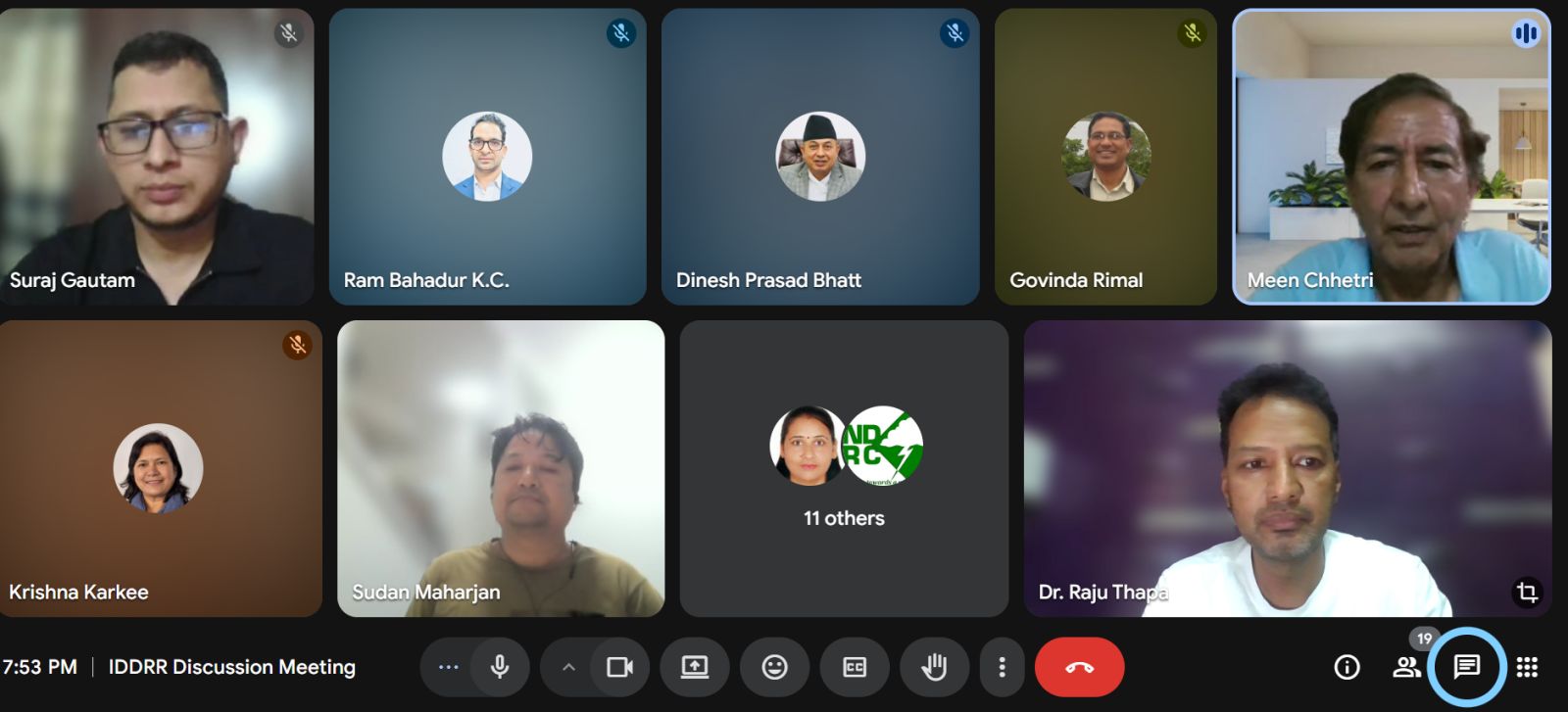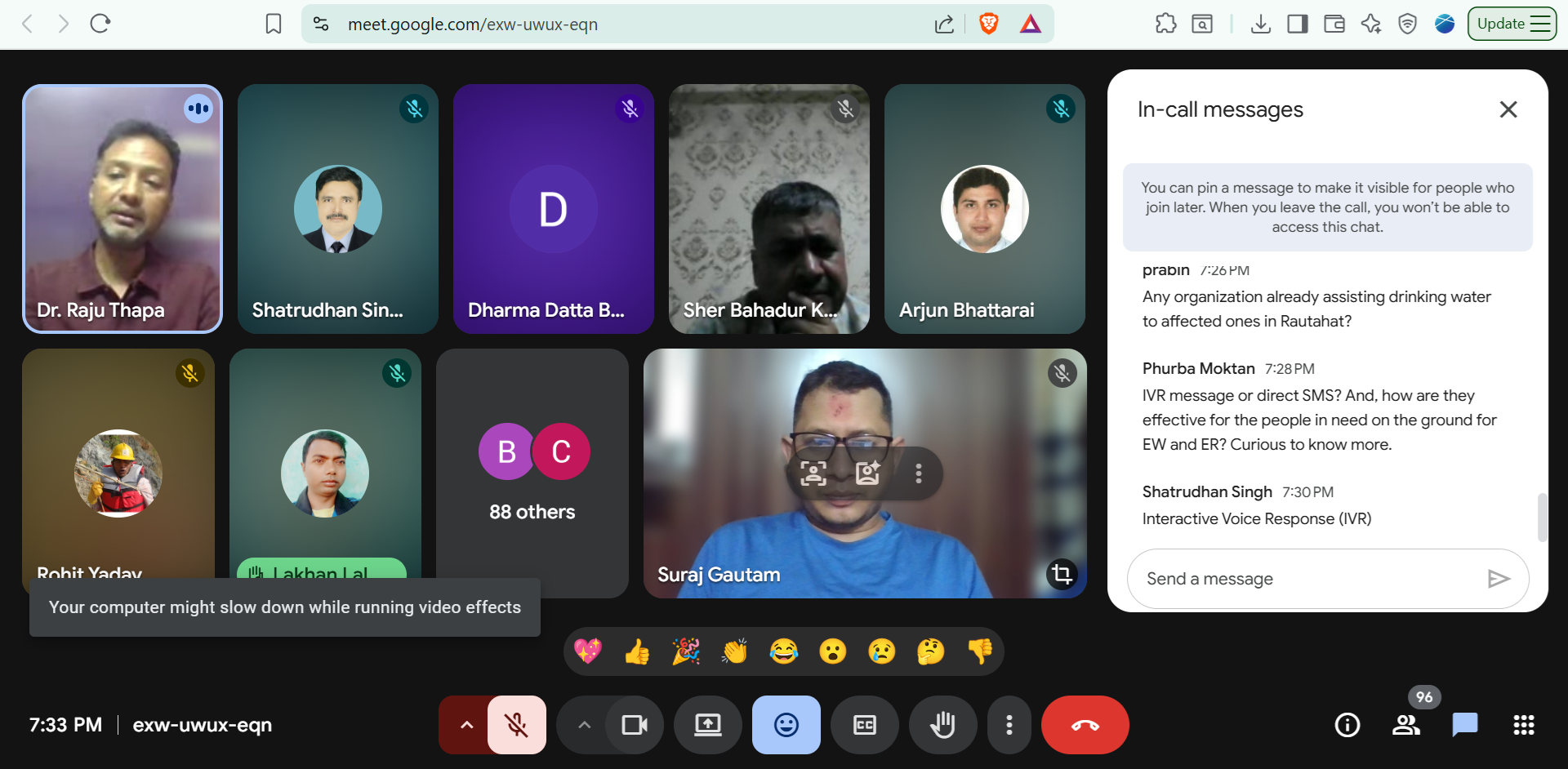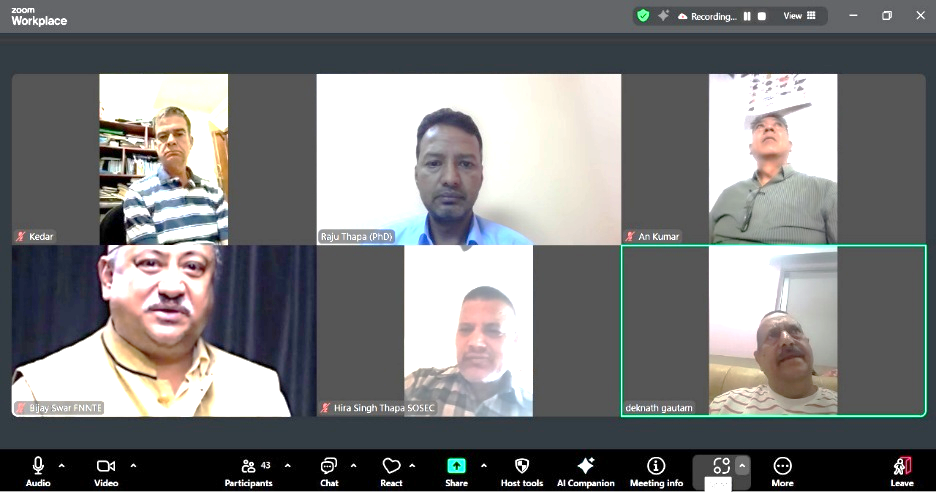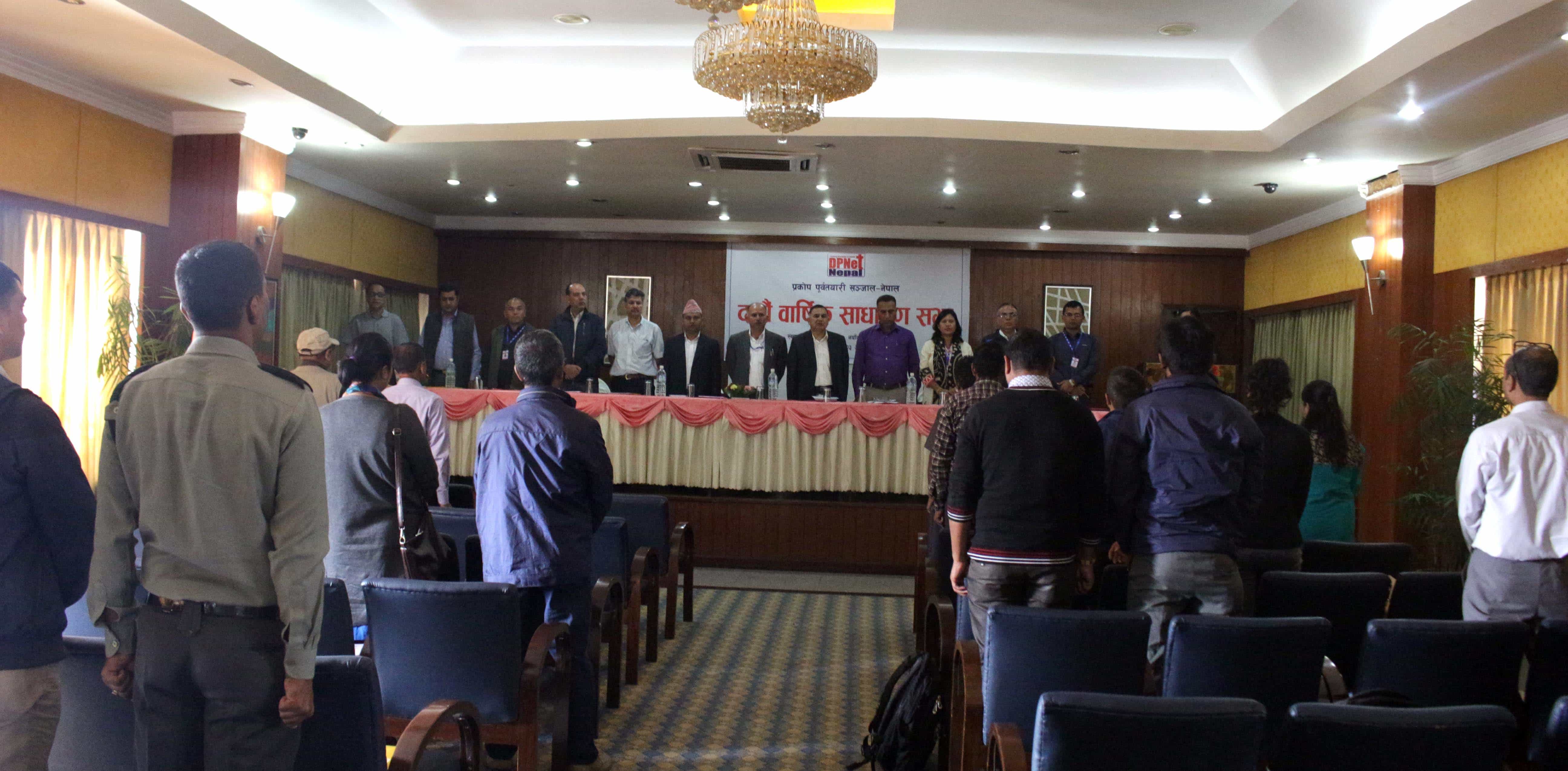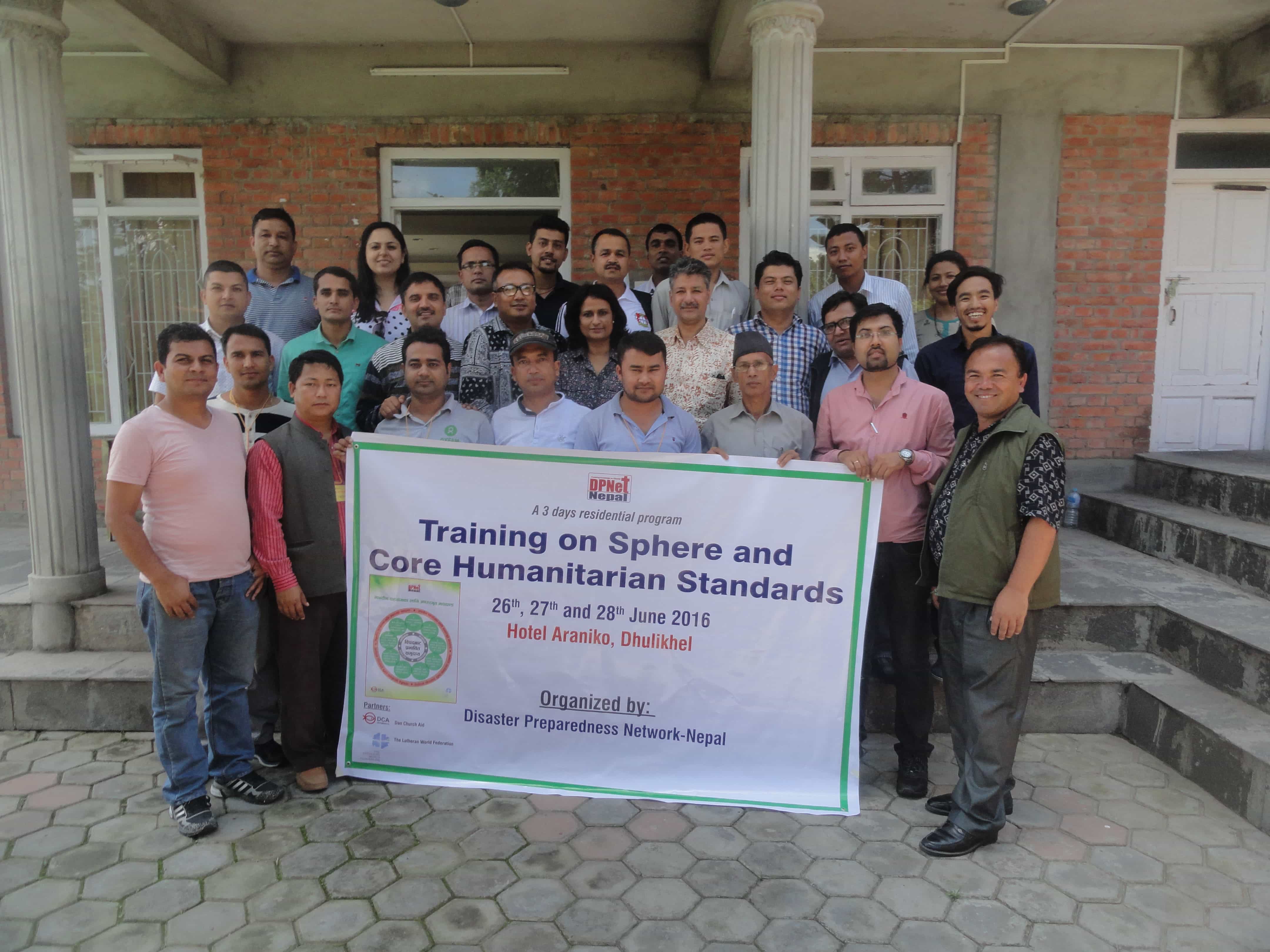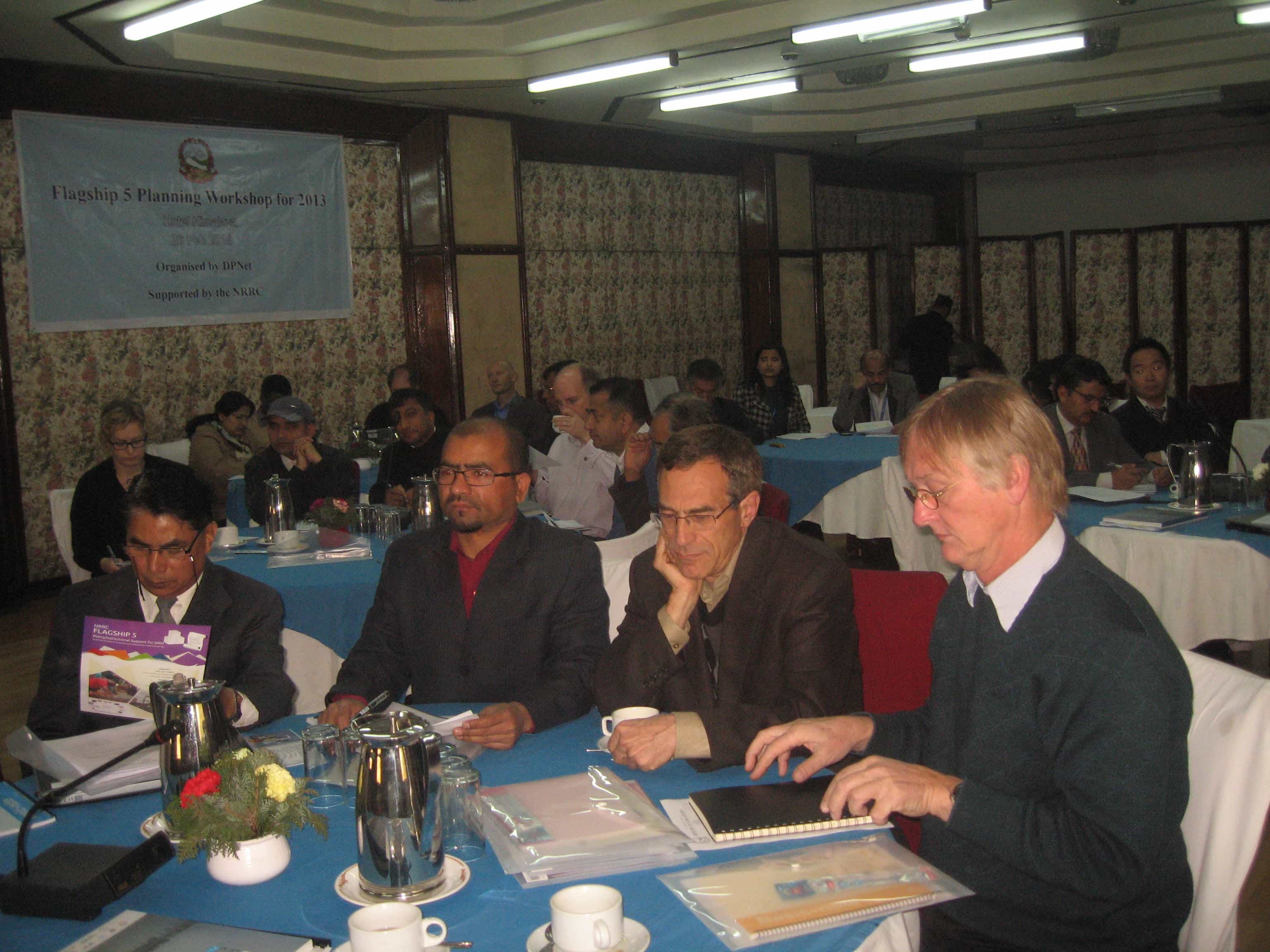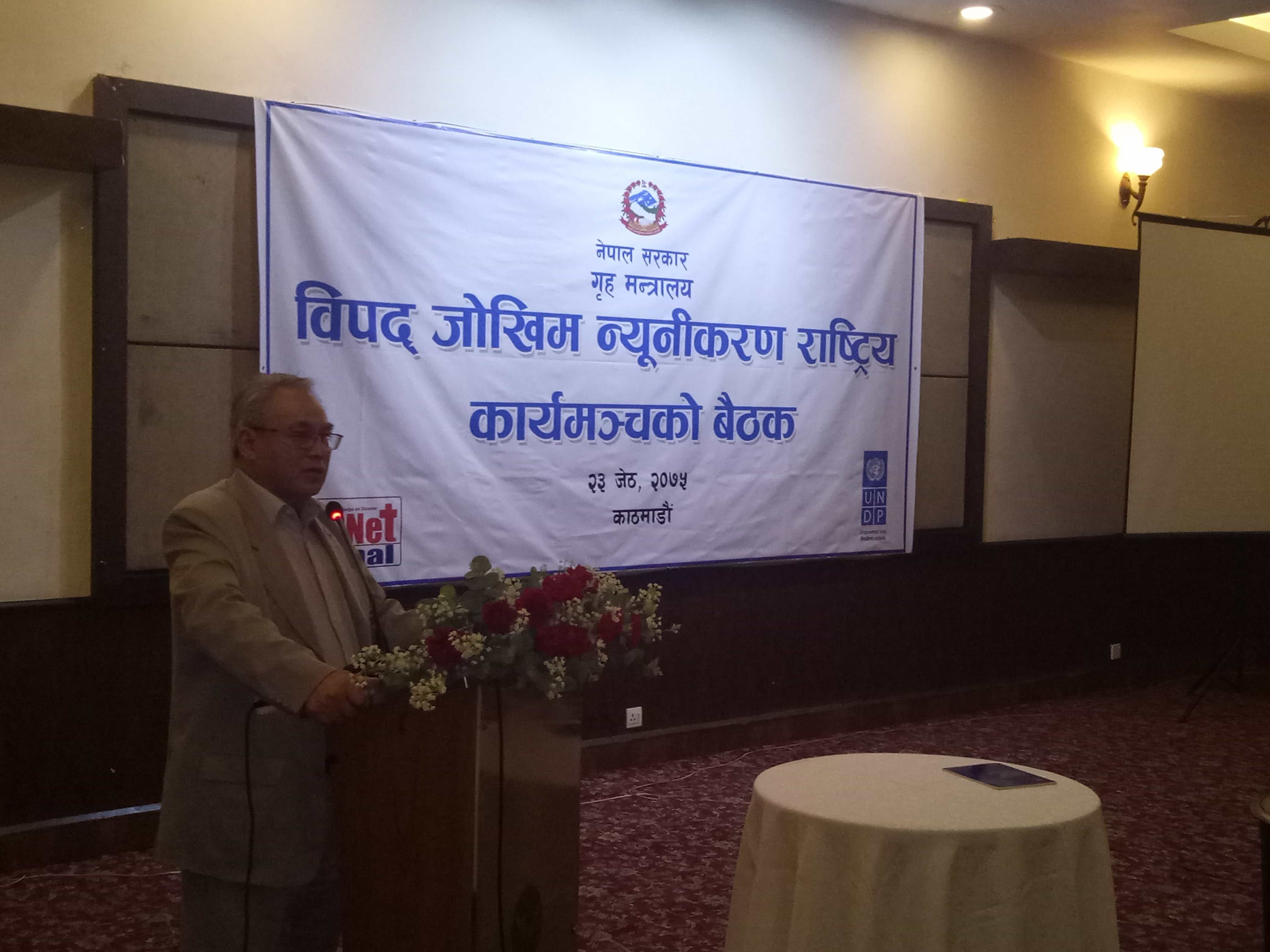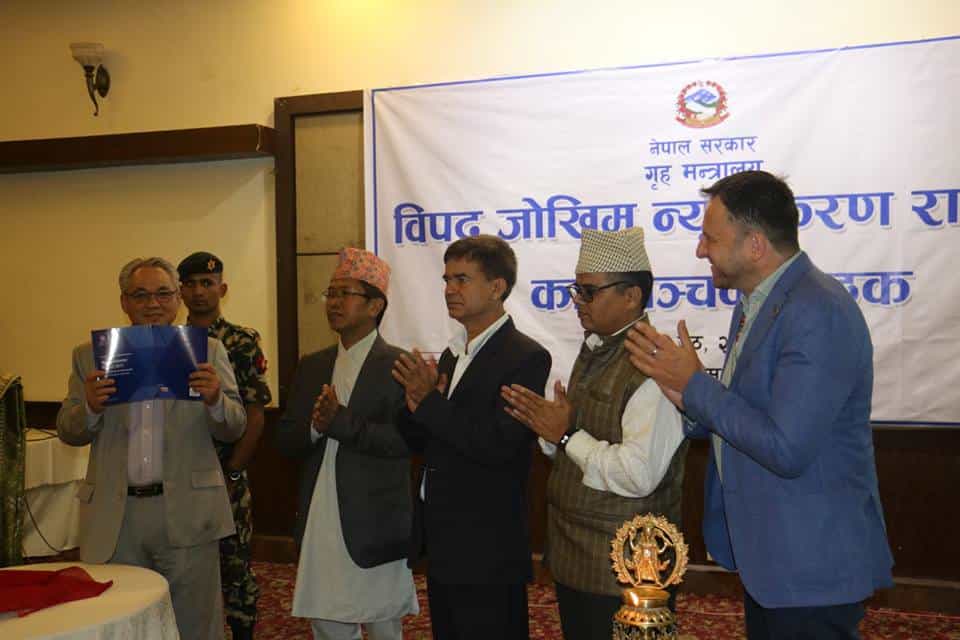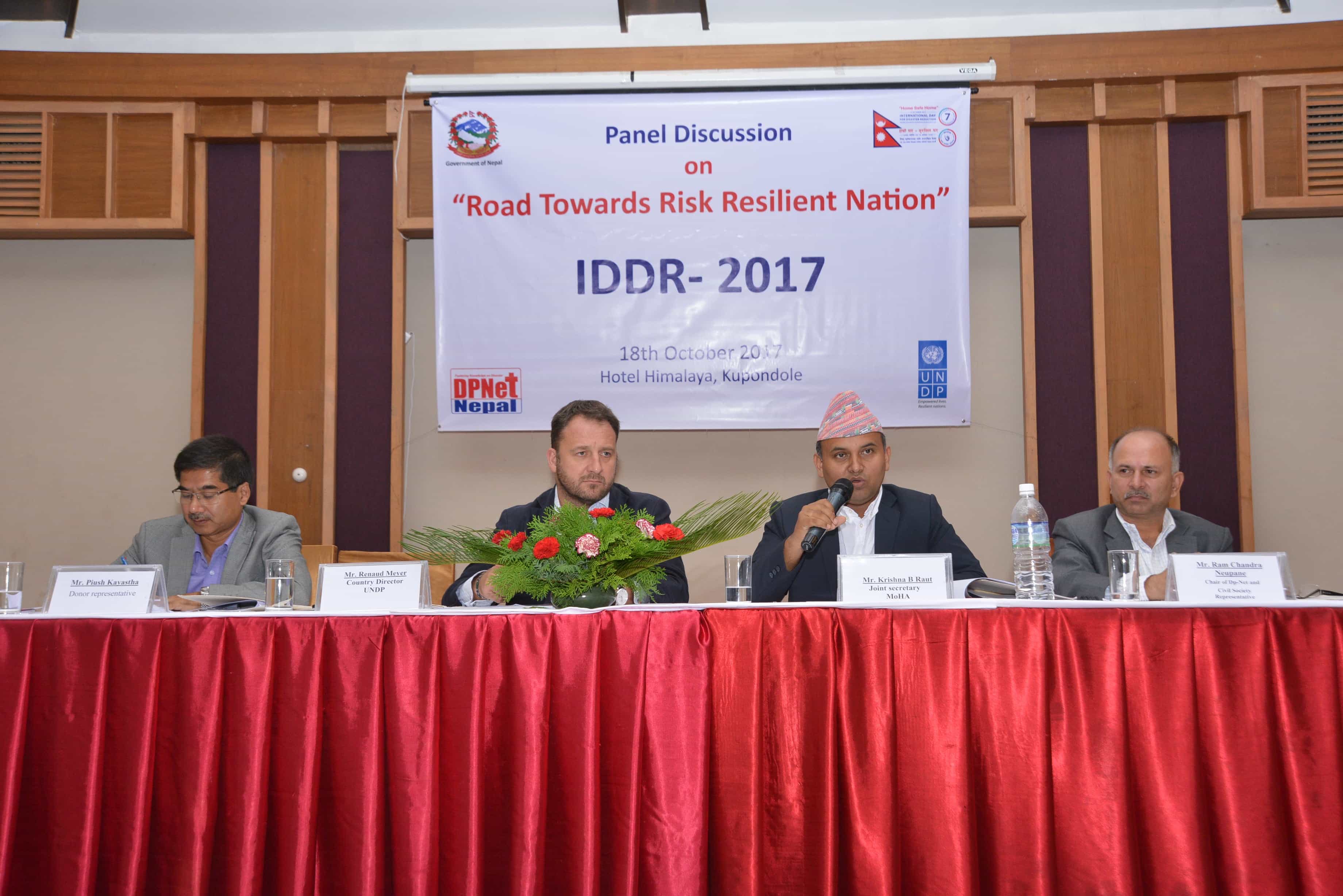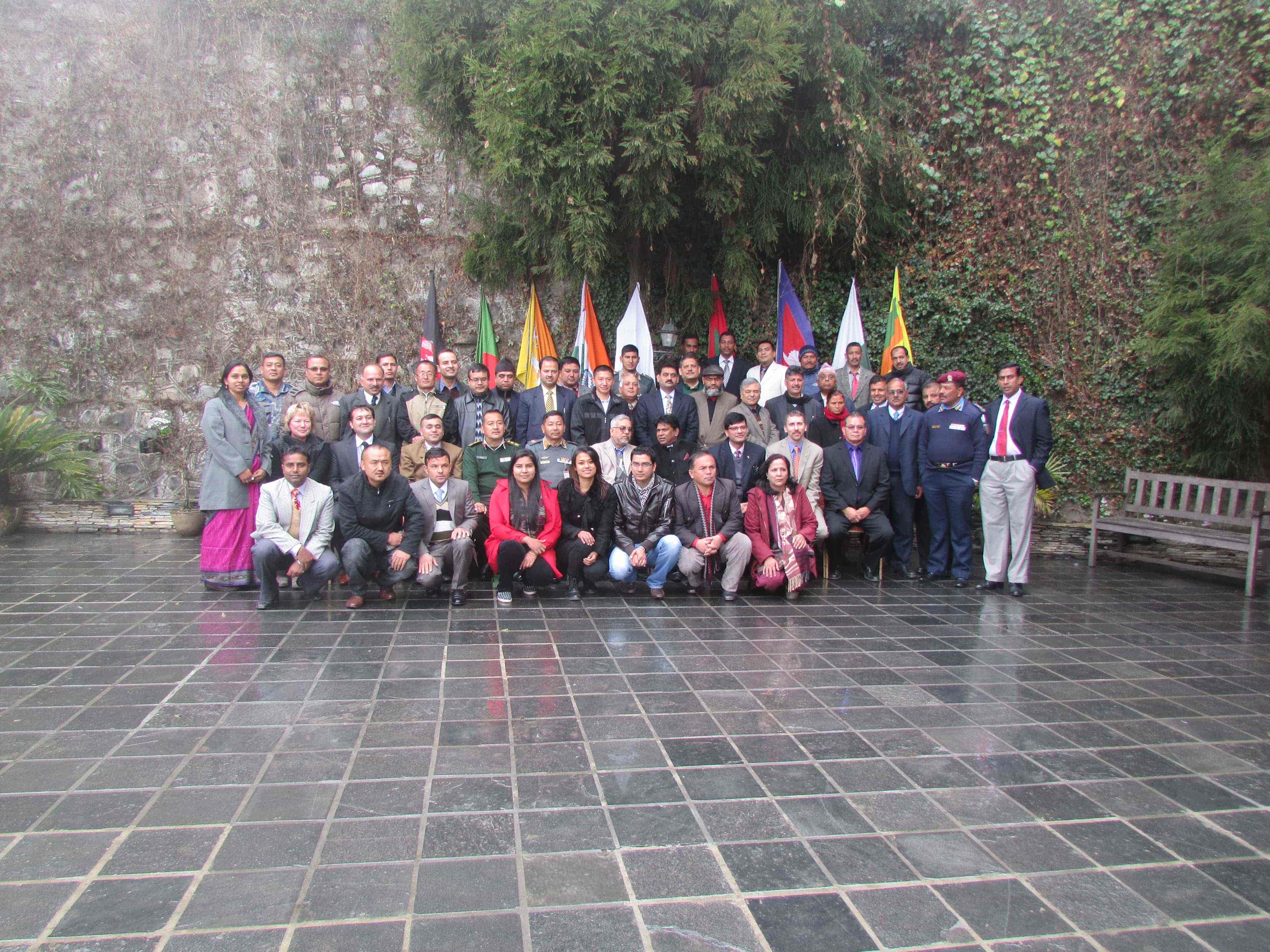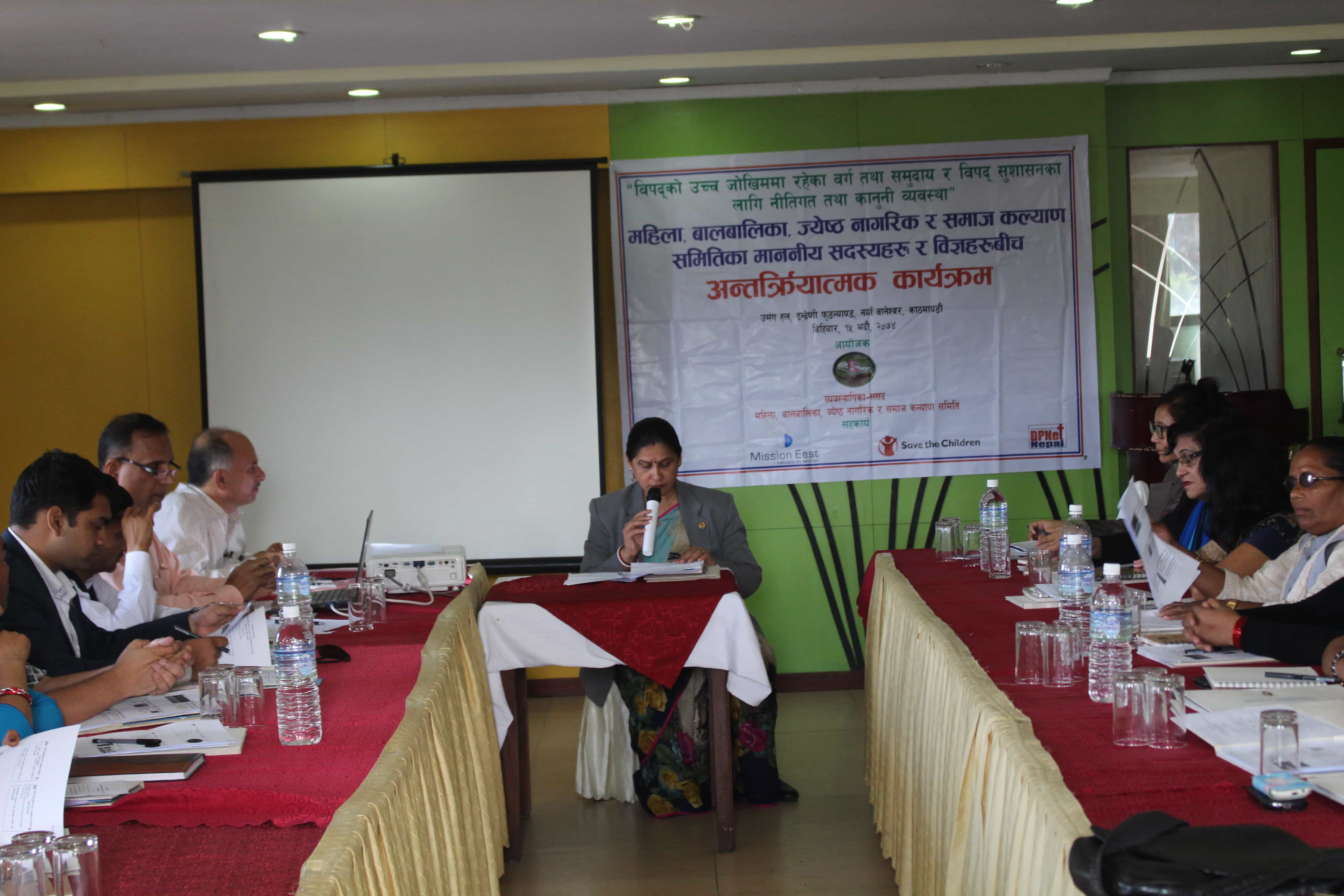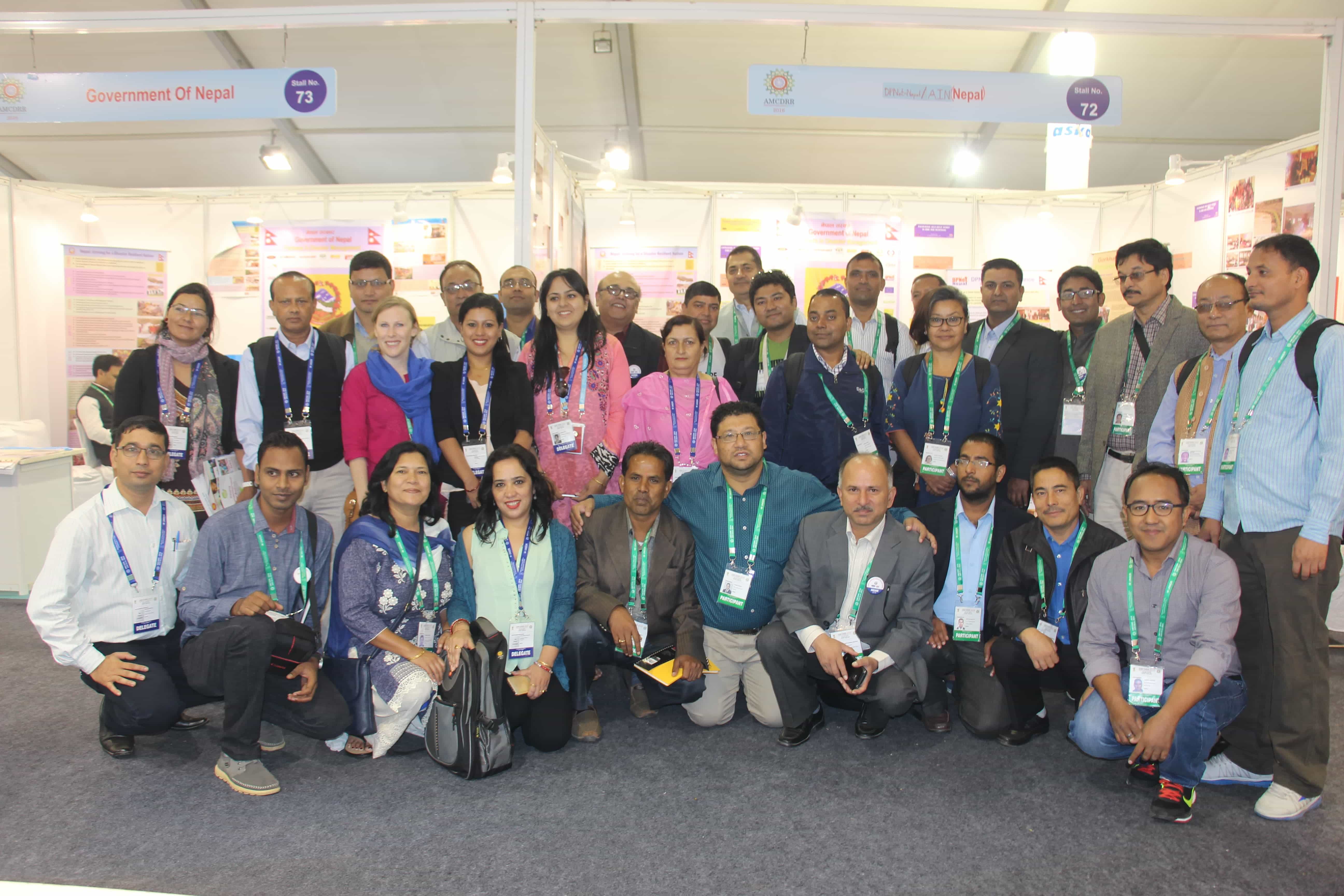International Cooperation for Developing countries to reduce their Disaster Risk and Disaster Losses, Commemorating International Day for Disaster Risk Reduction - 2021
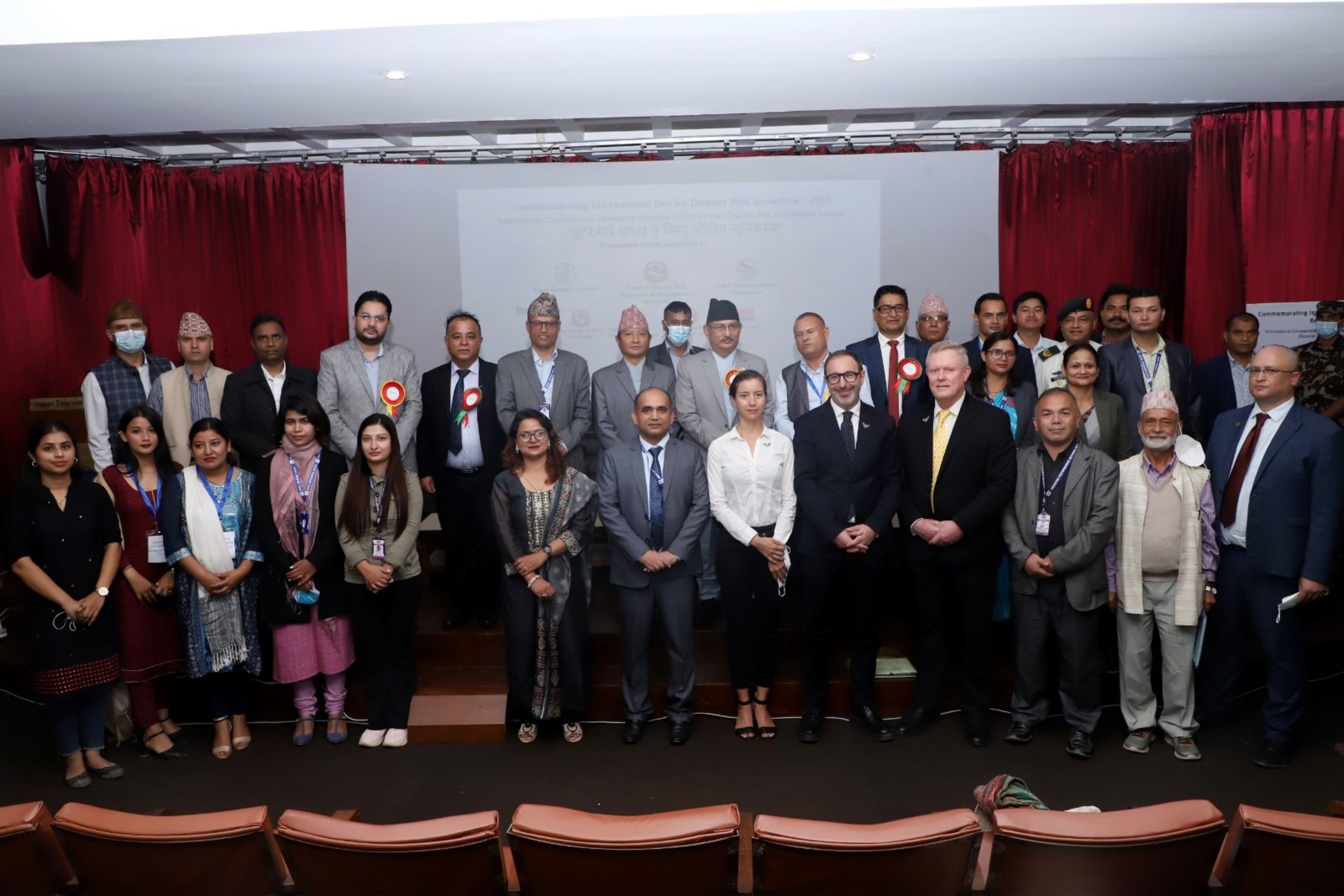
The program International Cooperation for Developing countries to reduce their Disaster Risk and Disaster Losses, Commemorating International Day for Disaster Risk Reduction - 2021 was jointly organized by the National Disaster Risk Reduction and Management Authority (NDRRMA), Nepal Geological Society, Nepal Hydrological Association and supported by Department of Mines and Geology, Department of Electricity Development, Disaster Preparedness Network Nepal (DPNet) Nepal, Tribhuvan University, UNDP Nepal, Nepal Tourism Board and National Society for Earthquake Technology- Nepal (NSET) on 22 October 2021 on Nepal Tourism Board (NTB), Bhirkutimandap.
The program was facilitated by Lok Bijaya Adhikari, General Secretary of Nepal Geological Society. The Chief Guest of the program was Hon’ble Minister Bal Krishna Khand, Ministry of Home Affairs, Government of Nepal. The program was started with the Chairmanship of Dr. Ananta P Gajurel, President of Nepal Geological Society. The special guest of the program was Mr. Shankar Das Bairagi, Chief Secretary and the guests of the program were Mr. Sagar Kumar Rai, Secretary of MOEWRI, Mr. Devendra Karki, Secretary of MOEWRI, Dr. Roshan Pokhrel, Secretary of MOPH, Mr. Arjun Prasad Pokhrel, Secretary of MOICS, Mr. Tek Narayan Pandey, Secretary of MOHA, Mr. Ram Prasad Ghimire, Director General, DMG, Mr. Susil Acharya, Director General, DoWRI, Mr. Sailendra Khanal, IG of APF, Mr. Shailesh Thapa, IGP, Mr. Bishnu Belbase, Executive Director of GRDB and Ms. Anita Niraula, Joint Secretary of NDRRMA, Prof. Dr. Bishal Nath Upreti.
The representatives of the program were from UNDP, Nepal Army, Disaster Preparedness Network Nepal (DPNet), Nepal Geological Society (NGS), Nepal Hydrological Society (NHA), National Society for Earthquake Technology (NSET), Tribhuvan University, Research organizations and Academia, civil society organizations, media, and individuals.
Altogether 145 participants participated in the program.
The slogan for the program was “जुटेर मात्रै सम्भव छ विपद जोखिम न्यूनीकरण”
There were a total of two sessions: The inaugural session and the technical session
1st Session - Inaugural Session
· Mr. Moti Bahadur Kunwar, Convener, IDDRR Organizing Committee - 2021 gave the welcome speech and highlighted the program. He welcomed each chief guest, special guest, guest, and participant of the program. He highlighted the theme of IDRR 2021- (Net). The International Day for Disaster Risk Reduction (IDDRR) is celebrated each year with the collaboration of government and non-government organizations. He highlighted the causes and effects of the disaster which causes lots of damages in infrastructure, loss of lives of people, loss of agricultural land/products. He shared the aim, mission, and role of the Sendai Framework (2015-2030) during the disaster. Nepal is highly vulnerable to disasters such as climate-induced disasters, pre-monsoon disasters. He shared about the events of pre-monsoon disasters and disease disaster of COVID -19 and their effects as well.
· Dr. Ananta P. Gajurel defined the terminology hazard, disaster, and risk in the Nepali language. He said our first priority should be prioritizing the disaster and search for effective mitigation to measures. There are many researchers and academia who have studied climate change, disaster management technologies for disaster risk reduction and management. However, these stakeholders should be motivated more. Nepal Geological society has configured capacity enhancement training for disaster risk reduction and management. He added that the Federal, Province and local levels should also collaborate to find the root causes of the events from the local level for identifying and mitigating the disaster.
· Mr. Anil Pokhrel, CEO of National Disaster Risk Reduction and Management Authority highlighted major points of the Disaster Management Act- 2017. He said that the hotspot area identification is being carried out. He explained the status of Melamchi Gorkha, Manang, Darchula flood and other climate-induced disasters, pre-monsoon disaster, cascading risk, and others due to increasing sea level and climate change. He shared the disease disaster of Salaha Kira that was seen last year. He further explained the importance of joint action of government, private sector, media, and other sectors. He added that the past actions and experiences of disaster management should be addressed and invent more new technologies. He explained the relief provisions provided in the Himalayan, Hilly, and Terai regions of Nepal. He highlighted the positive work carried out by Nepal Army during the disaster. He also encouraged to have international cooperation and collaboration. Learning from international mitigation of disaster management may be an effective way to implement. He further shared about data system knowledge and update data in the DRR portal.
· Mr. Sagar Kumar Rai, Secretary of MOEWRI explored Nepal, which is located in a hazard zone due to natural aw well as human-induced factors. He said that learning of new techniques and skills to be safe from disaster is very important at primary stage. He heartily accepted to welcome the suggestion of the participants and said he is always ready to help in disaster management as per need.
· Mr. Arjun Prasad Pokhrel, Secretary of MOICS said that we should identify our own role in DRR&M cycle. There are different techniques, ideas and skills used in international level. These should be used as an experience. Disaster relief materials should be prepared in Nepal as well.
· Hon’ble Minister Bal Krishna Khand, Ministry of Home Affairs inaugurated the Commemorating IDDRR-2021 and highlighted the status of many people that are directly affected by the disasters. Nepal is rich in water and forest resources, which should be preserved as well as used, agreeing to need by maintaining sustainability and natural environmental balance. Nepal is rich in freshwater resources. However, the shifting of river channels has been directly affecting the settlement areas, infrastructure, and lives of people. Moreover, there are several events like floods, landslides, etc. that trigger the loss of agricultural lands. Therefore, we must scientifically analyze all the data and properly implement the findings for the disaster risk reduction process. Since 2020, COVID-19 has been affecting people in Nepal negatively. Generally, there has been an increase in disaster trends in the past few years. We must adopt new technologies for disaster reduction and mitigation processes. The outcome of following the disaster risk reduction protocol by each person at the local level helps to keep our development sustainable and create a balanced natural ecosystem.
Ms. Monika Jhaa, Vice President of NGS gave a vote of thanks to each and every participant in the program.
2nd session – Technical Session I
The technical session was further divided into two session. The technical session I was chaired by Mr. Anil Pokhrel previous and past events of the area the program. He highlighted some of the disaster events and vulnerable stations addressed and encouraged Early Warning systems. Rapporeteurs was Ms. Amar Chand Thakuri, Department of Irrigation and Mr. Deepak Basnet, Department of Mines and Geology.· Mr. Shiva Baskota, Department of Mines and Geology, gave a presentation on the “Melamchi Disaster: Preliminary Investigation on Causes and Consequences”. The study was about the Indrawati watershed. The presentation included the extent of the damage, before and after the debris flow status in the Melamchi area, regional geology of the area, rocks and soils found in the region, and precipitation and river hydrograph. He shared the predicted possible causes, the status of Melamchi Ghyang and the talus material, and the triggered point. He explained about the Glacial Lake Outburst (GLOF), its possible causes and status, the earthquake, rainfall, glacial marine and the status of Melamchi. He further shared the current status, disaster timeline, sediment deposition, damage extent, discharge and existing hazard of Bhemathang. He differentiates the mass balance between Melamchi and Bhemathang. He finally explained the key findings and lessons learned from the study.
Discussion:
The previous events/studies in the area, recommendations, and key findings of the study were discussed.
· Dr. Ananta Man Singh Pradhan, WRRDC presented about “National- scale “Landslide Susceptibility In Artificial Intelligence Framework”
He shared the trends of landslides that have occurred in Nepal, the status of the responsible institute, their implementing institute, vulnerable landslide management project, rapid assessments, reconstruction, rehabilitation, and awareness. He shared the past records and data of past landslides. The presentation included the susceptibility of landslides by preparing a landslide inventory, landslide hazard assessment, and landslide propagation. Finally, he discussed the national and international collaborations that have occurred thus far, as well as the future plans.
Discussion
It was discussed how to identify errors during the inventory map preparation process and how to sort them.
· Dr. Archana Shrestha, Department of Hydrology and Meteorology, gave a presentation on “Monsoon Disasters in Nepal: Efforts and Challenges in Risk Reduction” via zoom. She shared the monsoon disaster overview, types of disasters in the monsoon season, rain induced cascading disasters, Monsoon 2021, the first disaster of Monsoon 2021 in Melamchi and Manang, major floods and landslides in the Narayani and Bagmati Basins, and efforts and impact based forecasting in disaster risk reduction. The presentation included the disasters in Sindupalchok, Rasuwa, Baglung and Myagdi districts. She further explained the challenges in Disaster Risk Reduction, changes in disaster patterns, observed precipitation trends in Nepal, the recent post monsoon disaster, and the role of coordination and collaboration in DRR
Discussion
It was discussed about the cause and effect of pre-monsoon and post monsoon.
· Mr. Shanmukhesh Chandra Amatya, Vice President of NHA presented on “Disaster management interest of donor agencies”. He shared the visual presentation of debris flow. He shared the Disaster management cycle, losses of human lives from disaster in 2078, damages by landslide in road, damming, hydropower, settlement area, bank cutting, eroding. His presentation included the effects of landslide and flood, adaptation to disasters, awareness/preparedness, mitigation technologies, debris flow mitigation works, Early warning sensor used for flood, extensometer for prediction of slow moving landslide, Early warning sensor used for debris flow, hazard map preparation. He shared the Interest of international donor agencies in mitigating disaster. He explained the animation about the role and triggering of event of groundwater base flow. He finally shared about the present intuitional setup for DRM in Nepal, policy, act, rule and regulation regarding DRR&M and encouragement and cooperation to donor agencies with national priority in disaster management.
2nd session – Technical Session II
The Chairperson of Technical session II was Dr. Ashesh Dhungana, MD DM, Chief Consultant Physician, Bir Hospital and Rapporteurs were Ms. Shila Pokhrel and Mr. Prakash Chandra Luitel, Gelogist.
· Dr. Sudip Khadka, Post-Doctoral Research Scientist of Miyo Clinic Hospital, Rochester, USA gave presentation on “Lack of preparation results in increased mortality due to COVID 19 in Nepal”. He focused on COVID -19 status and risks, in Nepal. He shared the daily new confirmed COVID – 19 cases trend, new wave in Nepal, case fatality rate of COVID -19, outcome in Nepal, average case fatality rate of COVID-19, positive cases by age group in Nepal, mortality by age group, share of daily COVID-19 tests that are positive and underlying causes of COVID-19.
Discussion
It was discussed about the pandemic pre forecast mechanism.
· Dr. Sameer Adhikari, Ministry of Health and Population gave presentation on “COVID-19 crisis management and cooperation with international communities”. He explained about the regulations, legislation, policy, coordination and communication of COVID-19. His presentation included financing, logistic, testing, surveillance monitoring forecasting and early warning, response, vaccination, good practices, and issues of COVID-19.
Discussion
The status of availability of medical equipment including oxygen during COVID -19 pandemic. It was discussed about past and present condition of health sector after COVID-19 pandemic.
· Prof. Dr. Bhupendra Kumar Basnet, COVID-19 Chief and Medical Director, Bir Hospital shared the presentation entitled “COVID-19 unified central hospital, Bir hospital”. He introduced about Bir Hospital, their services, hospital capacity and services, human resources availability in health sector, before and after COVID-19. His presentation further included COVID -19 in Nepal, preparation done for COVID -19, hand washing station and fever clinic conditions, activities during COVID pandemic, condition of COVID Ward/ICU, current activities on patient management, PPE donning/doffing and current COVID activities, he further shared about Rt- PCR for COVID -19 at Bir Hospital Lab, Rt PRC lab condition, COVID unified hospitals in Kathmandu, COVID 19 dedicated hospitals in Province level, COVID cases, COVID-19 vaccination center, National and International supports, challenges of hospitals and way forward.
· Ms. Anita Niraula, Joint Secretary of NDRRMA summaries the all 7 presentation. She explained about the status, problems, challenges and way forward of NDRRMA. She shared about National Disaster Risk Reduction and Management Act, policy and strategic planning. She shared the provisions on Authority, Province, District and Local level. She highlighted about data included in BIPAD portal by major hazards and disaster in Nepal. She shared the no of incident occurred due to earthquake, landslide, lightning, flood and fire in BIPAD portal. She shared the working area, worked area and understanding of NDRRMA.
Concluding Session
Dr. Ananta P. Gajurel, President of NGS, gave the concluding remarks. He gave thanks to every presenter and participant. He requested the presenter to get their presentation in the form of text files for publication, then closed the program.
